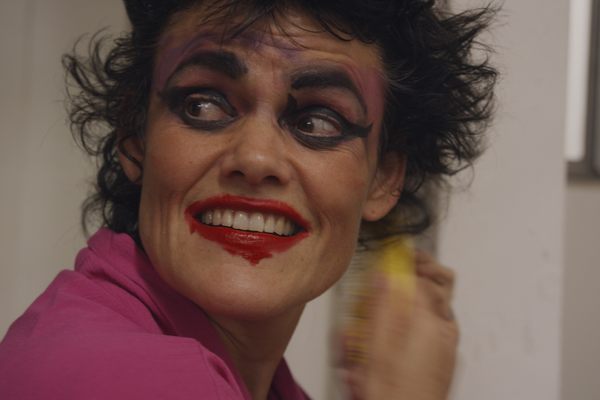Magic and Your Lizard Brain: The Mind Tricks behind Conjuring Ghosts
An illustration from Ellis Stanyon’s “Magic: in which are given clear and concise explanations of all the well-known illusions, as well as many new ones” (1910) (via Wikimedia)
Everyone has a lizard brain.
Your lizard brain is that primitive part of you that’s frightened by the unknown and comforted by familiar patterns. It seeks those patterns and attempts to neatly categorize all your experiences so you can streamline your thought process. In almost every situation, this is extremely helpful. It allows you to attend to more pressing matters. If our caveman ancestors had to question the concept of reflection every time they saw their image in a puddle, many more of them would have been eaten by wolves or stomped to death by mammoths. But the lizard brain, while helpful, is a bit like a high-strung friend — trustworthy, dependable, and a lifesaver, but really fun to play a trick on now and then.
Magic tricks, particularly tricks of light, are designed to exploit our lizard brains by exposing us to scenarios that fly in the face of known patterns and purposefully defy easy categorization. The dissonance between what we’re seeing and what we expect based on similar situations produces a heady combination of delight, awe, and just a tinge of fear.
It’s worth noting that many of these types of tricks were popular with turn-of-the-century magicians. Unlike the Victorian spiritualist, these magicians denied having supernatural powers. It was the beginning of what Teller (of Penn and Teller fame) calls “the unwilling suspension of disbelief.” If a magician presented a ghost to the audience, the audience wasn’t expected to alter their belief system to start including ghosts. They were only expected to be confounded by what they were seeing. But if you examine how these tricks are done, you’ll see it’s not your eyes that lead you astray — it’s your lizard brain. Let’s explore a few of these lizard brain illusions.
The first illusion is incredibly straightforward. It plays off the expectations that we can only see objects when light is reflecting off of them and that objects continue to exist even when there’s no light and we can’t see them anymore.
A skeleton in a magic lantern show (via Magic Lantern Shows)
Imagine we’re walking through a haunted house. A projected image of a skeleton pops up on a blank screen in front of us. The effect might happen fast enough to startle us and the sight of the skeleton might unnerve us. But the experience doesn’t awe us. We aren’t deeply shaken by it. Why is that?
First of all, what we call “projection” is actually just reflected light that contains enough visual information to allow us to interpret it symbolically. I might be frightened by the symbol of the skeleton, but that speaks to a higher-functioning part of my brain. The lizard brain has no use for something as complex and ambiguous as symbols. What the lizard brain sees in this scenario is the light in the form of the projection and the blank screen, which is a familiar object that’s being illuminated. We’re not confounded by the experience because at its core, it conforms to a pattern we see every day: light reflects off the surface of an object and thus we’re able to see the object. In this case, we’re seeing a decidedly pedestrian screen. So to disrupt that pattern and confuse the lizard brain, we need to keep the ephemeral image of the skeleton, but ditch the screen.
One trick we can use is to swap the screen for smoke. Since smoke is actually just tiny particles suspended in the air, each particle is capable of reflection the same way that the screen is; it’s just not a physical object that we can reach out and grab. The skeleton projection now becomes much more confusing, and therefore awe-inspiring to the lizard brain. We’re a baffled by how we can see light reflecting off a thing that isn’t a physical object. When the light is gone, it seems that the projection surface vanishes as well. This effect is called phantasmagoria.
The problem with projecting on smoke, though, is that it’s hard to localize the particles you’re reflecting off of. In most cases, the stray particles allow you to see the beam of light leading straight to the source (in this case, the projector). Anyone who’s seen the sun come out on a foggy day can understand it. The awe vanishes once we understand the source of the light so the next trick is to obscure the source as well as the projection surface. That’s what the effect known as Pepper’s Ghost does.
The Conjurer’s Ghost, showing a Pepper’s Ghost performance (via the Richard Balzer Collection)
Take a look at the above image. The woman in yellow is performing her part from the basement, but the audience is seeing her glowing, translucent image onstage where it’s juxtaposed with scenery and actors who are obviously real.
What the audience is seeing is actually her reflection on the front of a transparent piece of glass. Since the light that’s focused on the woman in the basement is very bright, she becomes the reflective light source that’s in turn reflected in the angled piece of glass that’s used as a projection surface. Since the audience can see through the projection surface, they can also see through her glowing image. If the light on her fades out, her reflection fades away, and she disappears from stage.
Pepper’s Ghost illustration from the 19th century (via Museum Victoria)
It’s a tricky little setup, but it takes a usual experience (seeing a reflection) and removes the usual signifiers of reflection that allow the lizard brain to find the pattern and categorize it as such. In this case there’s no obvious light source and no visible projection surface. What’s more is we’ve concealed the thing being reflected by angling the glass. This breaks the pattern of most reflective surfaces we come in contact with, which are typically horizontal (puddles) or vertical (mirrors). With these signals missing, the image of the woman defies easy categorization. She doesn’t appear to be fully human or fully reflection, and the dissonance causes wonder and amazement.
The next trick takes the ghostly image one step further. If you were to try to interact with a Pepper’s Ghost, you would reach out and touch an angled sheet of glass. It would immediately click that this was just a tricky reflection and the effect would be ruined just like revealing the light source ruined phantasmagoria. But the final way to conjure ghostly images doesn’t require a special light source like phantasmagoria or even a discoverable projection surface like Pepper’s Ghost. It’s so convincing that it confuses your sense of touch as well as your sense of sight. (To be fair, it was only created decades ago, not centuries like the previous two examples).
In this version of the trick, you think you see an item sitting on a table, in this case, a pig. When you reach for it, the pig slips through your fingers and you find that the center of the table, which seemed like a solid mirrored surface, is actually a hole. Fortunately, you don’t have to start believing in ghost pigs. The image is a mirage (note the Latin root “mir-,” as in mirror or miracle, which incidentally means “wonder and amazement”). The pig is actually sitting safely inside the table. Its image is projected with parabolic mirrors concealed within the table that reflect the ambient light coming through the hole at the top. Once you take one of these tables apart it’s easy to understand exactly how the reflections work, but the illusion still won’t stop fooling your brain.
 Diagram of a mirage (via exploratorium.edu)
Diagram of a mirage (via exploratorium.edu)
That’s because the trick is working on two levels. Pepper’s Ghost showed you an image that didn’t seem possible to the rational mind (a glowing translucent ghost) by concealing the mechanics that would make such an image possible. But because the image was immediately flagged as impossible, your rational brain was easily able to step in and let you know that your eyes were deceiving you, even if your lizard brain prevented you from figuring out how. You didn’t really need to touch it to know it’s not real. The mirage, on the other hand, shows you an image that is immediately flagged as possible and is easily categorized by your lizard brain. It fits the familiar “objects sitting on surfaces” pattern that you encounter every day. Until you chose to interact with it, you didn’t even know you were being fooled. The sum of the effect fits so neatly into a simple category, you can’t stop putting it there even after you know you’re wrong.
That’s actually the beauty of these tricks (and why I can write this piece without being a spoilsport who’s ruining illusions for you). You lizard brain is so reliably persistent that knowing how the trick is done doesn’t stop the effect from working. With other tricks I could guide you away from the misdirection and point you toward the sleights of hand and little trap doors so you could feel smarter than everyone who’s fooled by it, but not here. These ghosts are all in your head.
A projection of a ghost (via Early Visual Media)
Elizabeth Harper is a lighting designer based in Los Angeles. Her past credits include Play Dead at the Geffen Playhouse directed and co-written by Teller. When not designing lights she enjoys researching and documenting Catholic saints’ relics for her blog All the Saints You Should Know. She’s written and lectured on the subject for Atlas Obscura, Death Salon, and the Morbid Anatomy Library.
Magic Week is February 24-28, 2014 at Atlas Obscura. Follow along on Twitter (hashtag #MagicWeek), Facebook, & Tumblr.
















Follow us on Twitter to get the latest on the world's hidden wonders.
Like us on Facebook to get the latest on the world's hidden wonders.
Follow us on Twitter Like us on Facebook